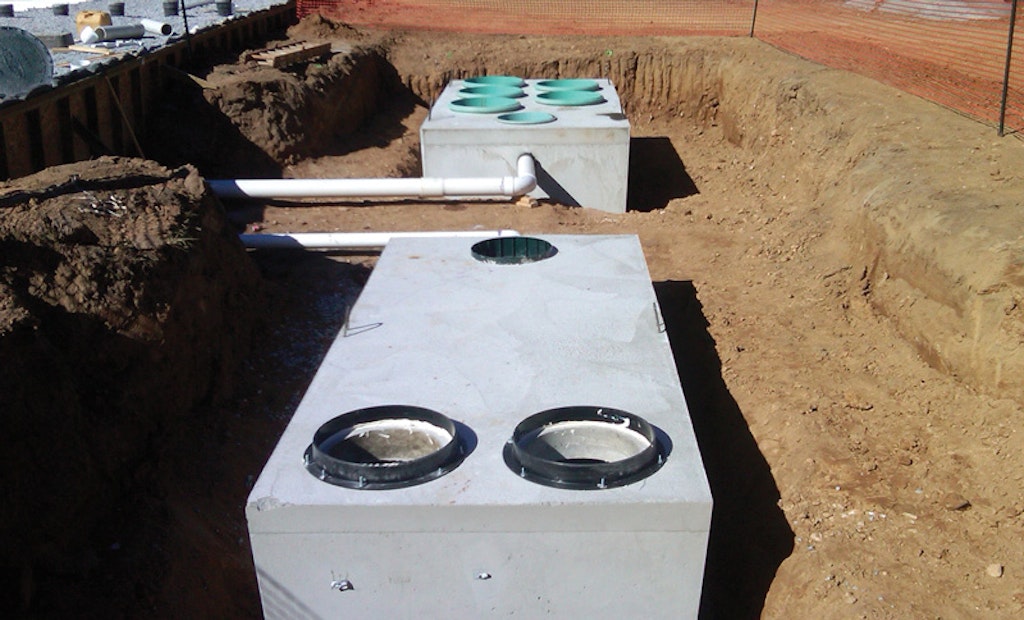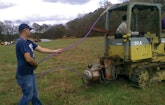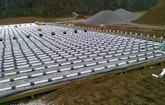
Interested in Pumps?
Get Pumps articles, news and videos right in your inbox! Sign up now.
Pumps + Get AlertsThe sheer size and complex demolition and build schedule for a system replacement project near Golden Pond, Ky., provided a huge challenge for EcoStruct Group of Pleasant View, Tenn. Glenn Marcum of EcoStruct and his design team – engineers Bob Pickney of Adenus and Bill Johngrass of URS Corp. – were called on to update the wastewater system for the largest equestrian campground in the eastern United States, and do it without hindering the campground’s operation.
Wranglers Campground, part of the Land Between the Lakes National Recreation Area and owned by the U.S. Forest Service, was created in the 1970s by the Tennessee Valley Authority. The property lies between Kentucky Lake, a flowage of the Tennessee River, and Lake Barkley, which is a flowage of the Cumberland River. Both empty into the Ohio River. This bit of geography turned out to have implications.
The campground has silt loam and silty clay loam soils and about a 50-foot elevation change. Distance to the lakes is about a mile. A couple of intermittent streams carry 3 to 4 inches of water in dry weather.
Project challenges
As the campground was developed and expanded, crews used nonstandard materials and apparently no coordinated design. As a result, the old system was greatly undersized for the now 70-acre property with 213 campsites, four communal bathhouses with toilets and showers, a gatehouse, a general store, a horse barn and farrier service, several horse-washing stations and a dump station for RV tanks. The camp draws about 75,000 annual visitors and more than 100,000 in October for a large rodeo.
To meet this need, the team in 2010 designed a 30,000 gpd system with a recirculating sand filter, drip irrigation system, STEG and STEP collection system and backup generators. Total collection system tankage installed was 45,000 gallons.
The horse-washing stations presented a peculiar problem. Horses shed their winter coats of hair in late March and early April. Wash stations were previously tied directly into the old leachfields, which were plugged by hair. Where possible Marcum disconnected stations from the main system and gave them dedicated leachfields. Stations that had to be tied into the new wastewater system because of their location were fitted with settling chambers.
Aside from nonstandard materials, there were no drawings showing the location of the old system components. “Some of the best help came from people who had been camping there for 20 years and had seen some of the changes,” Marcum says. Crews took great care in digging, but sometimes that was not enough.
As workers were digging up an old septic tank at one of the bathhouses, staffers told EcoStruct the electrical service came from the other direction. It didn’t. The bucket of an excavator caught the power cable lying across the top of the existing buried tank and not encased in conduit. When the operator swung the bucket, he ripped the electrical box off the bathhouse wall. “There were sparks flying. It was very scary,” Marcum says.
It took immense coordination to complete the job with the campground open. A bathhouse job typically started the prior week with a series of phone calls to coordinate timing. On Monday, as the last weekend campers packed and left, the crew would do preparation work at the selected bathhouse. On Tuesday morning workers shut off the water, pumped the old septic tank dry, dug it out, broke it up and hauled it away.
New tanks and a 90-ton crane were delivered. Each bathhouse received a pair of watertight concrete tanks: A 5,000-gallon primary tank, which empties into a 3,000-gallon secondary tank connected to the collection system. All tanks on the project came from Jarrett Tanks of Ashland City, Tenn. Workers set the new tanks in place, made hookups and tests, and backfilled. All this was accomplished through the end of the day on Wednesday. Thursday was a contingency day, but by Friday the bathhouse had to be ready for the weekend.
Working in water
Geography became important in the spring of 2011. Severe flooding occurred in Missouri and southern Illinois where the Mississippi and Ohio rivers join – not too far from the campground. The U.S. Army Corps of Engineers closed its dams to reduce water flow, and some of that water backed up into EcoStruct’s project. System installations had to be planned around the lakes’ water elevation, and daily reports were provided to EcoStruct. It was never more than 5 inches and affected only one bathhouse when a crew was setting new tanks.
Marcum also took precautions to make sure those new concrete tanks would not float. A secondary off switch with a float prevents the lift station pumps from draining the tank below 70 percent full. The combined weight of concrete and effluent will keep the tank in the ground even if its exterior is covered with water.
Three-quarters of the campground waste is collected by gravity flow. For the other quarter, effluent flows by gravity to a lift station where Sta-Rite pumps connected to 2-inch force mains feed the sand filter. The longest linear run of gravity collection pipe is 3,500 feet. The total pipe run is 4,000 feet, using 6-, 4-, 3- and 2-inch SDR 21. Slopes on the gravity pipes are 1 percent or a bit more, and every septic tank installation has filters to block solids from entering the collection pipes.
The sand filter is 55 feet by 112 feet 6 inches, with between 4 and 5 feet to groundwater. Marcum zoned the filter by splitting it in the center with a low wall. Half the filter is connected to a recirculation system fed from a 3,000-gallon tank. The discharge tank is also 3,000 gallons, with Arkal disc filtration between the pump house and the drip field.
An Adenus Technologies PLC computer runs the system. Toggle switches allow manual operation of everything, but on the outside of the panel is a touch screen, which Marcum encourages operators to use. The system can also be operated remotely with an iPad, he says. The drip field consists of 43,200 feet of 1/2-inch Netafim pipe, divided equally into nine zones with a loading rate of 0.15 gpd. Floats in the recirculation and distribution tanks tell the computer the water conditions so it can alter the pumping cycle automatically.
Keeping the pumps on
Marcum’s solution for the Forest Service was comprehensive in more ways than one. “They’re in the middle of nowhere with old power lines and an old power grid system,” he says. “Losing power out there happens all the time. All it takes is one storm and a falling tree.”
To make sure the system is always operating and campers are able to use the toilets and showers they paid for, EcoStruct installed a pair of 50 kW Generac diesel generators. Automatic switches sense whether grid power is present and turn the generators on or off accordingly. The generators have fuel for 24 hours and have split duties. One runs the well house and one of the bathhouses. The other runs the wastewater plant, another bathhouse and the gatehouse.
One thing that can defeat all the machinery is people, and the horse owners were yet one more challenge. It’s one thing to have a drip field. It’s another thing to have a dozen horses walking across the field when it’s wet and the ground is soft. Marcum’s team fenced the whole 6 acres of drip field to keep it undisturbed. They fenced the sand filter as well.
When the project was done, Marcum gave the campground a full set of pictures on a USB flash drive in addition to a set of as-built plans. There won’t be any wondering about component location, and it will aid in future maintenance and repairs, he says. After all the challenges and struggle, the result of the project may be judged by what didn’t happen. “They never lost a rental on a site, and they were obviously extremely happy about that,” Marcum says.









